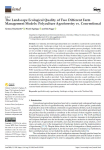Chiaffarelli G., Sgalippa N., Vagge I. (2024). The landscape ecological quality of two different farm management models: polyculture agroforestry vs. conventional. Land, 01/10/2024, vol. 13, n. 10, p. 1598.
https://doi.org/10.3390/land13101598
https://doi.org/10.3390/land13101598
| Titre : | The landscape ecological quality of two different farm management models: polyculture agroforestry vs. conventional (2024) |
| Auteurs : | G. Chiaffarelli ; N. Sgalippa ; I. Vagge |
| Type de document : | Article |
| Dans : | Land (vol. 13, n. 10, October 2024) |
| Article en page(s) : | p. 1598 |
| Langues : | Anglais |
| Langues du résumé : | Anglais |
| Catégories : |
Catégories principales 06 - AGRICULTURE. FORÊTS. PÊCHES ; 6.4 - Production Agricole. Système de ProductionThésaurus IAMM POLYCULTURE ELEVAGE ; AGROFORESTERIE ; AGRICULTURE INTENSIVE ; SYSTEME DE PRODUCTION |
| Résumé : | Low-intensity, diversified agricultural land use is needed to counteract the current decline in agrobiodiversity. Landscape ecology tools can support agrobiodiversity assessment efforts by investigating biodiversity-related ecological functions (pattern-process paradigm). In this study, we test a toolkit of landscape ecology analyses to compare different farm management models: polyculture agroforestry (POLY) vs. conventional monoculture crop management (CV). Farm-scale analyses are applied on temperate alluvial sites (Po Plain, Northern Italy), as part of a broader multi-scale analytical approach. We analyze the landscape ecological quality through landscape matrix composition, patch shape complexity, diversity, metastability, and connectivity indices. We assess farm differences through multivariate analyses and t-tests and test a farm classification tool, namely, a scoring system based on the relative contributions of POLY farms, considering their deviation from a local CV baseline. The results showed a separate ecological behavior of the two models. The POLY model showed better performance, with significant positive contributions to the forest and semi-natural component equipment and diversity; agricultural component diversity, metastability; total farm diversity, metastability, connectivity, and circuitry. A reference matrix for the ecological interpretation of the results is provided. Farm classification provides a quick synthesis of such contributions, facilitating farm comparisons. The methodology has a low cost and quickly provides information on ongoing ecological processes resulting from specific farm management practices; it is intended to complement field-scale assessments and could help to meet the need for a partially outcome-based assessment of good farm practice. |
| Cote : | En ligne |
| URL / DOI : | https://doi.org/10.3390/land13101598 |







